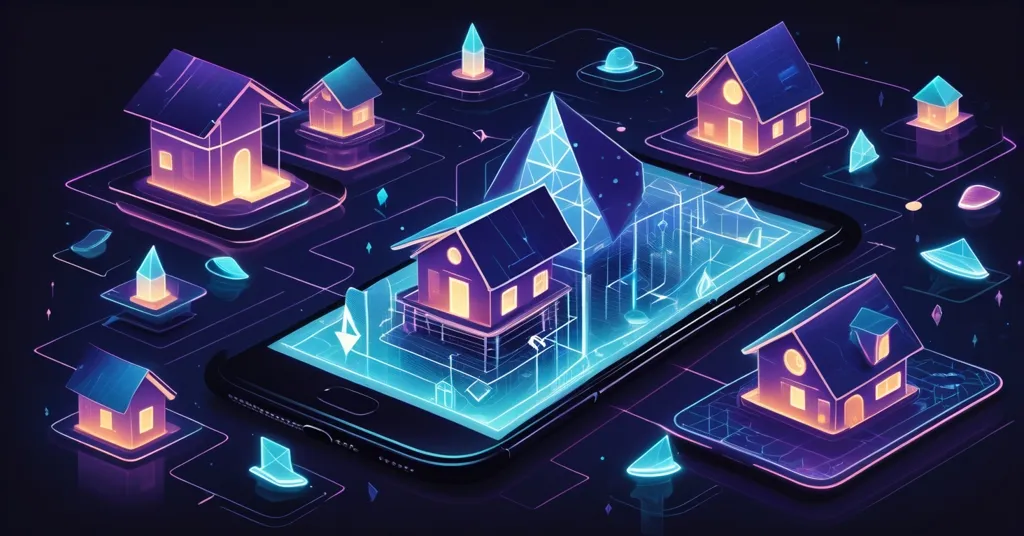Coldware ($COLD) Attracts Ethereum Whales with RWA Tokenization Smartphone Innovation

Coldware Sparks Interest Among Ethereum Whales as RWA Tokenization Gains Traction
Ethereum whales—those heavyweight investors with massive crypto holdings—are shifting their focus from speculative plays to real-world asset (RWA) tokenization, and a new contender, Coldware ($COLD), is grabbing attention with its hardware-driven approach. Promising to streamline the process of turning physical assets into blockchain tokens via a specialized smartphone, Coldware is positioning itself as a bridge between traditional finance and the decentralized world. But amidst the buzz, is this a genuine innovation or just another flashy pitch?
- RWA Surge: Tokenized real-world assets hit new peaks with $13 billion in private credit and $6.6 billion in U.S. Treasury tokens.
- Ethereum’s Grip: Ethereum commands 55.6% of the $3.86 billion RWA market, despite nagging scalability and cost issues.
- Coldware’s Angle: With the Larna 2400 smartphone, Coldware offers a secure, user-friendly way to tokenize assets, targeting Ethereum’s weak spots.
The RWA Revolution and Ethereum’s Double-Edged Sword
The crypto market has often been a playground for wild speculation, with meme coins like Dogecoin and PEPE soaring on hype before crashing back to earth. Now, a more grounded trend is emerging. Ethereum whales are betting on projects with real utility, and RWA tokenization is leading the charge. For the uninitiated, RWA tokenization means converting tangible or financial assets—think real estate, government bonds, or even rare artwork—into digital tokens on a blockchain. These tokens can be split into fractions for broader ownership, traded instantly, or used as collateral in decentralized finance (DeFi) protocols. It’s a mechanism that could inject liquidity into markets traditionally locked up tight, blending the security of traditional finance (TradFi) with the flexibility of DeFi. According to sources tracking the market, the space is booming, with $13 billion in tokenized private credit and $6.6 billion in U.S. Treasury tokens already circulating—a clear sign of a sector on the cusp of transformation.
Ethereum stands as the heavyweight champ in this arena, holding 55.6% of the $3.86 billion RWA market. Its strength lies in a mature ecosystem of smart contracts—self-executing agreements coded on the blockchain—that power most tokenization projects. But Ethereum isn’t without flaws. High gas fees, the costs users pay for transactions, can skyrocket during peak network activity, making simple trades or token minting prohibitively expensive for the average user. On top of that, its user interfaces often feel like a maze, alienating newcomers, and smart contract vulnerabilities have led to high-profile hacks costing millions. Despite these hurdles, whales are still pouring money into Ethereum-based RWA projects. Take Chainlink, a vital infrastructure player that connects real-world data to blockchains through oracles—think of them as trusted middlemen ensuring tokenized assets are backed by real value. In early May, whales reportedly dropped $9.1 million into Chainlink, signaling confidence not just in the project but in the broader RWA narrative.
Coldware’s Hardware Bet: Bold Innovation or Risky Overreach?
With Ethereum’s limitations laid bare, new players are vying to solve these pain points, and Coldware ($COLD) is making waves with an unconventional strategy. Unlike the typical software-only crypto project, Coldware is banking on hardware as the key to RWA tokenization. Their flagship product, the Larna 2400 smartphone, is designed to be a one-stop shop for tokenizing and trading assets. According to their white paper, the device features secure hardware enclaves—essentially tamper-proof digital safes built into the phone—that protect sensitive data and transactions from hackers. The pitch is straightforward: anyone, from a retail investor to a TradFi executive, should be able to turn a piece of property or a bond into a blockchain token with a few taps, no tech degree required.
“The Larna 2400 is designed to integrate seamlessly with Coldware’s platform, allowing users to easily tokenize and trade real-world assets.” – Coldware White Paper
Coldware claims this approach tackles Ethereum’s biggest headaches—security risks, clunky user experiences, and fragmented markets—by embedding everything into a single, intuitive device. Reports suggest Ethereum whales are taking notice, pivoting away from speculative meme coins and toward utility-focused projects like Coldware.
“Whales are shifting focus to utility-driven cryptocurrencies, and Coldware is rapidly emerging as their top choice.” – The Portugal News
But let’s slam on the brakes here. While the idea of a smartphone-powered tokenization hub sounds futuristic, there’s a giant red flag waving: much of the chatter around Coldware stems from sponsored content. Paid promotions don’t equal proof, and there’s a glaring lack of independent data or reviews to confirm whale adoption or the Larna 2400’s real-world effectiveness. Let’s call a spade a spade—if you’re paying for the spotlight, I’m not buying the hype without receipts. Beyond that, hardware solutions carry their own baggage, especially considering security risks tied to hardware solutions. What happens if your pricey Larna 2400 gets lost, stolen, or bricks itself? Are your tokenized assets gone for good, or does Coldware have a rock-solid recovery plan they’re keeping under wraps? And let’s not ignore cost—will everyday users fork over hundreds for a niche gadget when free software wallets are already out there? Then there’s the supply chain angle: hardware can be tampered with before it even reaches you, a risk software projects sidestep. Tying your financial future to one device feels like stacking your chips on a single, shiny bet. Without audits of the phone’s security or clear pricing details, Coldware’s vision is intriguing but smells like a gamble dressed up as a guarantee.
The Broader RWA Landscape: Giants and Challengers
Stepping back, Coldware isn’t the only name in the RWA game. The sector is buzzing with heavyweights pushing boundaries. Companies like Securitize and Ethena are building Ethereum Layer-2 solutions—think of them as side roads off the main Ethereum highway, designed to cut costs and speed up transactions—aiming to tokenize trillions in assets. Reports highlight this as a sign of TradFi’s growing hunger for blockchain integration, pointing to a potential multi-trillion-dollar market.
Major players are aiming to tokenize “trillions in RWAs” through collaborations on Ethereum Layer-2 solutions. – Cointelegraph
Elsewhere, MakerDAO is leveraging RWA collateral to stabilize its DAI stablecoin, while Chainlink’s infrastructure—offering Proof of Reserve to verify off-chain assets and tools for cross-chain connectivity—remains a backbone for the entire space. These established players set a high bar, and Coldware’s untested hardware angle faces stiff competition. Imagine tokenizing your family’s vacation home in minutes via a slick app—Coldware says it’s possible, but can a single device outshine protocols already handling billions in value?
Practical use cases for RWA tokenization are also expanding. Tokenized real estate could let everyday investors buy a slice of a skyscraper for pennies, democratizing wealth-building. Art tokenization fights fraud by proving ownership on-chain, while tokenized bonds offer instant liquidity to stodgy markets. Yet, for all the promise, the risks are just as real—more on that shortly.
Bitcoin’s Place in the RWA Puzzle
As champions of Bitcoin, we have to ask: where does the original cryptocurrency fit in this tokenization wave? Frankly, Bitcoin isn’t a major contender in RWA right now. Its design prioritizes ironclad security and decentralization over the flashy smart contract features Ethereum boasts, making it more a store of value than a tokenization hub. That said, Bitcoin isn’t entirely out of the game. Layer-2 networks like Stacks and the Liquid Network are exploring ways to bring tokenized assets to Bitcoin’s ecosystem. Stacks, for instance, enables smart contracts tied to Bitcoin’s security, while Liquid supports confidential asset issuance. Adoption is still niche, and Bitcoin’s community—often laser-focused on financial sovereignty—might resist pivoting to complex use cases. Still, these developments could align with Bitcoin’s ethos of disrupting the status quo, potentially carving out a unique role in RWA down the line. For now, though, Ethereum wears the crown in this space, flaws and all.
Risks and Roadblocks in the RWA Frontier
The potential of RWA tokenization to reshape finance is massive, but let’s not sip the Kool-Aid without eyeing the pitfalls. Smart contract bugs have drained millions from DeFi projects in the past—tokenized assets aren’t immune. Custody of the underlying assets is another minefield; if the real-world property or bond backing your token is mismanaged or stolen, your digital stake could be worthless. Market manipulation is a concern too—thinly traded tokenized assets could be gamed by bad actors. Then there’s the legal quagmire. Tokenizing securities draws scrutiny from regulators like the U.S. Securities and Exchange Commission (SEC), which has already cracked down on crypto projects for unregistered offerings. In the EU, frameworks like MiCA aim to govern digital assets, but compliance remains a headache. How will Coldware, with its hardware niche, navigate this mess when even Ethereum giants struggle? Past clashes—like Ripple’s multi-year battle with the SEC—show the road ahead won’t be smooth.
Hardware-specific risks add another layer for Coldware. Device dependency could alienate users who don’t want to shell out for a specialized phone, and a single point of failure (lose the device, lose access) feels like a step backward in a world of cloud backups. Smells like paid fanfare, doesn’t it? Without independent validation of Coldware’s tech or adoption, we’re left with more skepticism than excitement. We’re all for accelerating toward a decentralized future, but not at the cost of blind faith. Do your own damn research before jumping on this—or any—bandwagon. For those curious about the broader concept, resources like blockchain technology wikis or discussions on platforms like Quora about RWA tokenization can provide deeper insights.
Key Takeaways and Questions on RWA Tokenization and Coldware
- Why are Ethereum whales investing in RWA tokenization projects?
They’re chasing sustainable value over fleeting hype, drawn to RWA’s ability to blend TradFi’s stability with DeFi’s innovation, unlocking liquidity in massive markets. - How does Coldware aim to stand out in the RWA tokenization space?
Coldware pushes a hardware-first solution with the Larna 2400 smartphone, offering secure, easy access to tokenize assets, targeting Ethereum’s security and usability gaps. - What are the main challenges Ethereum faces in RWA tokenization?
Steep gas fees, scalability bottlenecks, and unintuitive interfaces hinder mass adoption, opening the door for niche solutions like Coldware to compete. - Can we trust the buzz around Coldware given its sponsored promotion?
Not without hard evidence—sponsored content often inflates claims, so dig for independent data on Coldware’s tech and adoption before buying the narrative. - What broader impact could RWA tokenization have on finance?
It could redefine asset ownership with fractionalization and transparency, creating a multi-trillion-dollar market that merges the best of TradFi and DeFi— if risks are managed.



